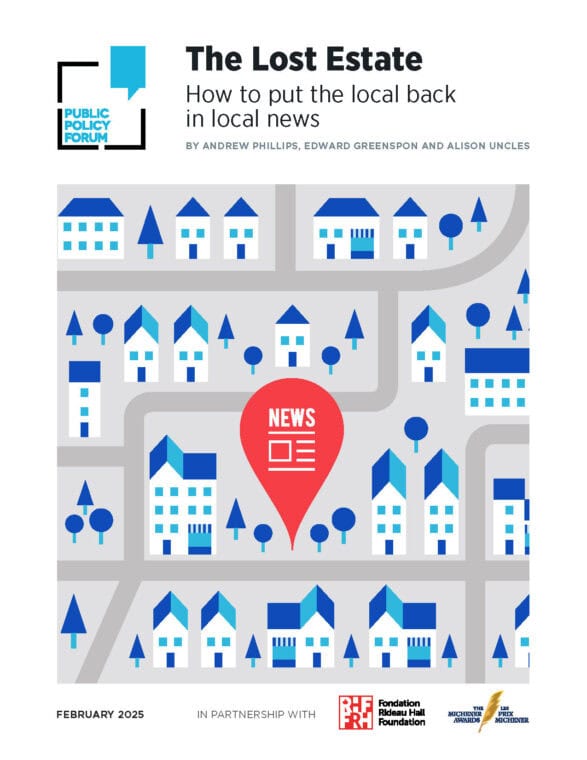Local news is in decline, but without it, communities become more polarized, their citizens detached from their neighbours and institutions, and trust breaks down. A new report from the Public Policy Forum offers some solutions – a couple of them aimed directly at Canada’s philanthropic sector.
These are the terms that have come to describe journalism in this decade, terms that are crowding out descriptions of journalism that have traditionally revolved around integrity and accountability: We now have “ghosts,” local newspapers that look familiar but in which local news coverage has been hollowed out, with journalistic decisions made by corporate overlords often thousands of kilometres away. “Pink slime” refers to partisan websites, funded by dark money, which peddle misinformation in the void left by the disappearance of local coverage. We are now familiar with “news deserts,” communities that have given up the ghost and have been left without any coverage of local politics, school board decisions, or sports teams.
Toronto Metropolitan University professor April Lindgren, chief investigator of the Local News Research Project, has tracked the closing of 526 local news outlets in 347 communities across Canada since 2008. The vast majority were community newspapers. In the same period, 402 new outlets opened, but only 274 of those survived. About half the closures were in communities of 20,000 or less.
In the United States, Rebuild Local News, a non-profit coalition advancing public policies to halt the local news decline in that country, reports that, on average, 2.5 newspapers close every week and 1,800 communities have no local news outlet.
This lack of a local voice, written and edited by community members, leads to more political partisanship, saps vibrancy from the community, leads to a lack of civic involvement, and threatens our democracy. Organizations with no journalist oversight have no one checking for corruption or malfeasance.
The threats to local news and ways to combat the erosion of local voices is the subject of a Public Policy Forum (PPF) report, The Lost Estate, released this week. Although The Lost Estate grew out of an October 2024 Charlottetown conference of some 60 local news publishers and broadcasters hosted by the Michener Awards Foundation and the Rideau Hall Foundation, it is another report in a series by the PPF, which has pioneered work on saving the flagging journalism ecosystem in this country. The conference heard firsthand of the challenges and anxieties involved in trying to keep local news in the hands of local citizens.

“Local news is where the rubber hits the road,” the report says. “It knits together communities and speaks to people where they live, quite literally. It builds connection through ephemera such as marriage announcements, obituaries and little league soccer scores, as well as delivering accountability to the very foundation of healthy, functioning democracies – school board meetings, courtroom trials, municipal councils.”
Philanthropy is growing rapidly in the United States around local news. Canadian philanthropists should follow suit.
“The Lost Estate” report
Without local news, communities become more polarized, their citizens more detached from their neighbours and institutions, and trust breaks down, the PPF report says. The vacuum is filled by social media, where truth and falsehood are engaged in fierce battle. The Lost Estate, drawing on exclusive polling by Ipsos, also indicates that while trust in media in general is eroding, it remains strong in local communities, where 86% of respondents still had trust in their local radio and newspapers, outstripping national newspapers (70%). Fully 87% said local news was key to a well-functioning democracy.
PPF offers a number of proposed solutions but aims a couple directly at the philanthropic sector in Canada. The sector cannot solve everything, but it does have a role; The Lost Estate calls for a bigger role. “Philanthropy is growing rapidly in the United States around local news,” the report says. “In addition to the small handful of U.S. foundations that are interested in journalism and democracy, a second wave of foundations and donors that were funders of other issues – including domestic violence, hunger, homelessness and poverty – have come to realize they’re not going to make any progress if there’s no local news. Canadian philanthropists should follow suit.”
Community foundations should be encouraged to support local news coverage as part of their wider missions to encourage social vitality, community health and local democracy.
“The Lost Estate”
The Lost Estate points out that there are more than 200 community foundations in Canada, as well as thousands of private foundations. But philanthropic help for local journalism is still in its infancy here. “Community foundations should be encouraged to support local news coverage as part of their wider missions to encourage social vitality, community health and local democracy,” the report says. “More media organizations should be knocking on those doors, and more community foundations should be stepping up.”
A number of large foundations are involved in local news, some for years. But numbers are hard to quantify. A report produced by the Inspirit Foundation in collaboration with Philanthropic Foundations Canada and the Local News Research Project says changes in regulations governing the types of organizations that can receive charitable dollars make it easier for foundations to fund local journalism. In an August 2024 update published by Inspirit and the Local News Research Project, they saw green shoots of hope for a bigger role from philanthropy. “By our count, at least three dozen Canadian foundations have now funded the activities of media outlets. Support is constrained, however, by two realities. The first is that demand for charitable services is at an all-time high so there is major competition for scarce philanthropic dollars. The second is that news organizations and organized philanthropy are still relative strangers. For a culture of philanthropic giving to journalism to thrive, the two sides need to become better acquainted.”
There is clearly a reticence among funders who ask why they should invest in journalism. A better case is that it could be an investment in shining a light on domestic violence, climate change, disinformation, or a housing shortage. If these issues are not highlighted by a vibrant local media, charities will find it more difficult to find donors to help combat local problems.
At a time when we’re concerned about polarization, this is an area where . . . philanthropic organizations in Canada can find that impact they’re working for.
Edward Greenspon, co-author, “The Lost Estate”
“The philanthropic sector is all about impact. Supporting journalism where it wouldn’t otherwise exist is very impactful,” says Edward Greenspon, a former CEO of PPF and one of the authors of The Lost Estate. “It’s important for democracy and it’s important for the good functioning of communities. At a time when we’re concerned about polarization, this is an area, where maybe it isn’t traditional for the philanthropic organizations in Canada, where they can find that impact they’re working for.”
There is no Canadian culture for this type of granting, says Greenspon, a former editor-in-chief of The Globe and Mail and author of the 2017 landmark PPF report on the shrinking media landscape in this country, The Shattered Mirror. Foundations look at journalism and see it can be contentious, the sector has clashed with governments in the past about being too political, and many have clearly defined purposes that don’t make space for local journalism, he says. “So, it was going to take a long while for a comfort level and for certain philanthropic organizations to revisit their strategies and say, ‘Actually, this path makes sense.’ I am not surprised that this is taking time. But I hope we are on the precipice of something.”
I have always thought that Canada was ahead of the US in the public policy part of this and behind the US on the philanthropy part of it.
Steven Waldman, Rebuild Local News
The US experience is one to emulate. Steven Waldman, the founder and president of Rebuild Local News and the co-founder of Report for America, attended the Charlottetown conference. “I have always thought that Canada was ahead of the US in the public policy part of this and behind the US on the philanthropy part of it,” he says. But he also came away feeling there was some interest in increasing philanthropic involvement in Canadian local news, “but it’s early days.”
Since its founding in 2017, Report for America has placed 658 journalists in 371 local newsrooms and raised US$30 million for local newsrooms. Report for America pays 50% of a journalist’s salary, with another 25% paid by the news organization; 25% is funded by local donors. Report for America helps with finding local donors. The organization does this work thanks to the funding of hundreds of foundations and donors. It accepts no government funding, but Waldman supports government help in keeping local news afloat. “The philanthropic sector in the US is bigger,” he says. “Some of it is cultural, but some of it is greater government involvement in Canada. There’s this weird thing [in the United States] where we allow and encourage people to get obscenely wealthy, but there is an expectation that you’re supposed to build some libraries, too.”
Three states – Washington, New York, and California – have set up programs to help local news through state university journalism programs. In addition, Maryland passed legislation in late January delaying any proposed sale of a local journalism outlet for 120 days to allow time for communities to organize to prevent sales to hedge funds or other anonymous corporate entities. California also passed legislation that compels state agencies to advertise in ethnic and local journalism. (In Ontario, Premier Doug Ford has directed government agencies to spend at least 25% of their advertising budget in local news.)
Report for America and Rebuild Local News are thriving, even in the face of President Donald Trump’s continued attacks on the media and his ranting about “fake news.” Trump has now frozen USAID, a humanitarian organization that provides US$268 million each year to local media in underserved areas of the world. But in a message that should be heeded by anyone apprehensive about how Pierre Poilievre might deal with local media, Waldman says of Trump’s actions, “If anything, it’s increased the interest from foundations.”
Canadian foundations that have dipped their toes in local-journalism funding report nothing but success.
Community foundations have an obligation to enter the arena of polarization and the fraying of community engagement and try to do something about it.
Sharon Avery, Toronto Foundation
Sharon Avery, president and CEO of the Toronto Foundation, says that civic engagement is in decline. To counter that trend, she says, people need healthy, vibrant local journalism that they can trust. “We’re in the middle of a shift,” she says of the sector. Part of that shift is the Toronto Foundation’s 10-year commitment to The Local, which has wowed her with its investigative work on issues typically ignored by larger media. Her foundation has provided The Local with $185,000, and from 2024 to 2028, it has pledged $50,000 annually. That is larger than a typical Toronto Foundation grant, but Avery says that as a community foundation there is an obligation to enter the arena of polarization and the fraying of community engagement and try to do something about it. “I couldn’t be happier with our return on investment,” she says.
The Rideau Hall Foundation’s support for local-journalism funding came from its association with the Michener Awards Foundation, which provides annual awards for public-service journalism. RHF also teamed with Michener on a journalism scholarship named for famed journalist Norman Webster, which provides $125,000 each to one English and one French newsroom aiming to develop local stories with impact to the community they serve.
“It is about the fabric of our democracy, which I personally grew up taking for granted. We can’t do that anymore,” says Teresa Marques, president and CEO of the Rideau Hall Foundation. RHF and Michener had honoured journalist excellence but began to think about what more could be done to connect communities. “We recognized there was a gap in journalism for small owner-operator newsrooms to come together and talk about what is working, not just what is not working. We wanted to see if there was an opportunity to create a new playbook that everybody could get behind.”
It is about the fabric of our democracy, which I personally grew up taking for granted. We can’t do that anymore.
Teresa Marques, Rideau Hall Foundation
Toronto’s West End Phoenix has partnered with the Maytree Foundation for a series of articles on housing and an innovative housing design competition and is now partnering with the Metcalf Foundation for work on countering misinformation and disinformation.
Metcalf has provided $150,000 over three years to The Local and $300,000 over three years to The Narwhal, an award-winning non-profit that often collaborates with large legacy media. West End Phoenix will receive a grant that hasn’t been formally announced.
When Jamison Steeve, a former principal secretary to premier Dalton McGuinty, came on board as Metcalf CEO last year, he was looking at local journalism as a vehicle that would help promote civil discourse and strengthen local democracy. “This seems to be a growing area of interest for a number of foundations,” he says. His work with West End Phoenix came about after Maytree recommended he meet with publisher Dave Bidini. “Good journalism is essential to good citizenry” – it can get people out of their silos, if even briefly, he says.
Bidini has, against steep odds, published West End Phoenix for eight years, funding a monthly print broadsheet focused on west-end Toronto with the help of close to 1,000 private donors, donations at the door for events ranging from politics to music, about 3,000 paid subscriptions, and advertising. Bidini, a musician and author, cherishes the relationship with individual donors, and while he has received government funding, it can’t replicate locals who are invested in his enterprise. But he concedes that a government lifeline that grew out of pandemic relief “saved our ass.”
After eight years, our muscle is strong enough that we can join the fight against misinformation and disinformation.
Dave Bidini, West End Phoenix
“To survive you need to have a little fairy dust,” he says, “but day in and day out, you have to be relentless. After eight years, our muscle is strong enough that we can join the fight against misinformation and disinformation.”
Bidini acknowledges that endowments and grants for all types of cultural and arts institutions is not really a Canadian tradition. “It is the American way of doing things. It’s new here and it’s going to be a matter of people getting used to this,” he says. “We need that.”
The key players are well known in the sector: Inspirit (funding local voices since 2019), Metcalf, the Wellesley Institute, the Toronto Foundation, the Winnipeg Foundation, the Atkinson Foundation, the Rideau Hall Foundation, Maytree, the United Way of Greater Toronto, and the Toronto YMCA. Since there is no registry identifying donors to local news, this is an incomplete list.
One of the great success stories has been The Local, a non-profit online magazine born at a 2018 dinner pitch by publisher Tai Huynh. As he wrote in The Philanthropist Journal last May: “With so many important causes in the city, where would journalism even stand within a pile of grant proposals? Unlike a local food bank or women’s shelter, journalism’s case for support can be nebulous, often filled with high-minded notions of democracy and civic engagement and short on practical outcomes you can throw into a spreadsheet. But who, if not the charitable sector, is more accustomed to stepping in to fill a gap left by the failure of markets?”
Wellesley, United Way, YMCA, and the Toronto Foundation stepped up. Metcalf came later. There are now 10 charitable donors, and The Local has not only won 19 national awards, but it now sponsors three fellowships, worth up to $6,000 each, for young or aspiring journalists looking to learn the craft – funded by donors. As a “registered journalism organization,” it can issue tax receipts for all donations.
Every issue that you care about in our society will be weakened if there isn’t that backbone of trusted local media.
Teresa Marques
One other crucial point: Bidini, Huynh, and others who receive foundation funding insist that it be “no strings attached.” And it is. Both sides understand the rules – or, as Huynh puts it, what the sector calls trust-based philanthropy, he calls editorial independence.
“Every issue that you care about in our society will be weakened if there isn’t that backbone of trusted local media,” Marques says. She sees momentum and big players coming to the table to determine how this can be done in Canada. “Maybe it’s because we are new to the party. Or maybe the party is just getting started. Either way, I’m good with it.”
There are already plans to reprise the Charlottetown gathering in 2025.

